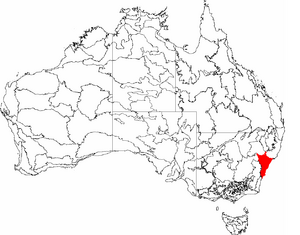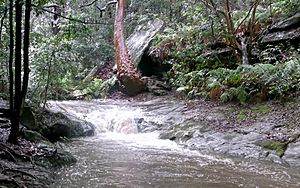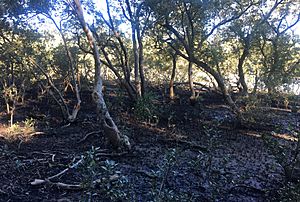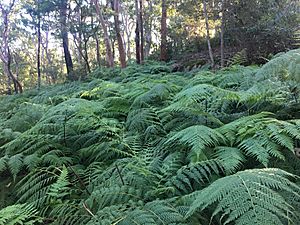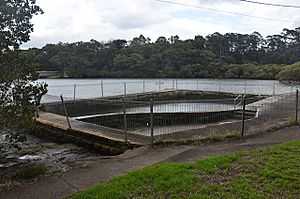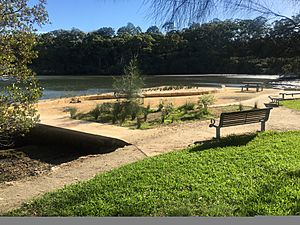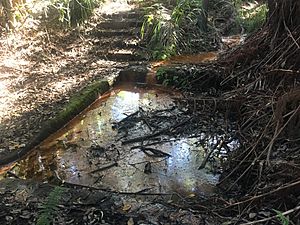Tambourine Bay, New South Wales facts for kids
Tambourine Bay is a beautiful bay in Sydney, NSW, Australia. It sits between the suburbs of Riverview and Longueville on Sydney's Lower North Shore. The bay and its creek flow into the Lane Cove River, which then connects to Sydney Harbour. The local council, Lane Cove, looks after the bay's edges and parks.
Contents
History of Tambourine Bay
Who was Tambourine Sal?
Tambourine Bay gets its name from a local woman called Tambourine Sal. People believe her real name was Sarah Leadbeater. She was married to the famous explorer and surveyor, William Lawson. Sarah was known for playing her tambourine in the streets of Sydney.
An author named Judy Washington suggested that Sarah Leadbeater would sometimes hide from the law in a small hut in the quiet bushland of Tambourine Bay. Sarah Leadbeater married William Lawson on March 23, 1812. She later lived on a farm in Prospect, New South Wales and passed away on July 11, 1850, at the age of 48.
Aboriginal Heritage in Tambourine Bay
Tambourine Bay is part of the North Sydney foreshore. This area was once home to the Cammeraygal people, who were part of the Eora Nation. The Cammeraygal people lived a semi-nomadic life, moving around to hunt and gather food. They relied on the tidal mangrove forests and rich wildlife of Sydney's North Shore.
Fishing was very important for them along the harbour. The Lane Cove River, which they called 'Turranburra', had many types of fish, crabs, and shellfish. Men and women used special fishing spears called 'fizz-gigs' and hook lines. They fished from canoes or rock platforms. Sometimes, larger animals like dolphins and whales would come close to the shore during winter. Evidence shows that Aboriginal people hunted animals like the Dugong and Green Turtle.
The Cammeraygal people used sandstone caves along the foreshore and rivers for shelter. You can still see signs of their activity, like rock prints, axe grinding marks, and stone carvings. Rock art was a way for the Cammeraygal people to show their spiritual connection to the land. Carvings of fish and people in the Lane Cove area show their strong link to nature. Experts believe there are about 4,500 Aboriginal archaeological sites in the Sydney area.
Sadly, many rock shelters were later destroyed by European settlers. They took minerals from the rocks for farming. Diseases like smallpox, which the Aboriginal people had no protection against, also greatly affected them. Today, a small number of residents in Lane Cove identify as Aboriginal or Torres Strait Islander.
Environment of Tambourine Bay
Native Plants (Flora)
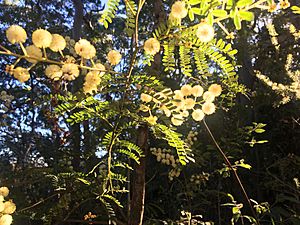
The Lane Cove Council works hard to bring back native plants to Tambourine Bay, especially in Warraroon Reserve. Mangroves, like Aegiceras corniculatum and Excoecaria agallocha var. agallocha, grow along the northern and western edges of the bay where the water is salty.
Higher up from the water, you'll find many types of Eucalyptus trees. These include the Forest red gum (Eucalyptus tereticornis) and the Rusty gum (Angophora costata). Smaller native plants, like the Australian Wattle (Acacia terminalis subsp. Glabrous), have sweet flowers that attract animals like possums and lorikeets.
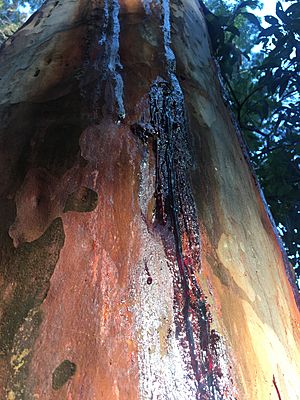
Invasive Plants
Invasive plant species are also found along the bay's foreshore. These are plants that are not native and can harm the local environment. Bush regeneration programs help to control these plants by weeding them out or using herbicides.
Some introduced plants have become very common. The Fishbone fern (Nephrolepis cordifolia) covers much of the forest floor. This fern is native to parts of Australia but has spread as a weed into the Sydney area, loving the damp soil in Tambourine Bay.
Native Animals (Fauna)
Birds
Many native birds live and find food in the wet sclerophyll forest around the bay. Common birds include the Sulphur-crested cockatoo (Cacatua galerita), Galah (Eolophus roseicapilla), and Rainbow Lorikeets (Trichoglossus moluccanus). They eat seeds, leaf buds, and blossoms from eucalyptus and wattle trees.
[[File:A Sulphur Crested White Cockatoo (Cacatua galerita), Cronulla, NSW Australia.jpg|thumb|Sulphur-crested cockatoo (Cacatua galerita)]) Birds of prey, like the Laughing Kookaburra (Dacelo novaeguineae), also live here. Kookaburras eat insects and worms from the forest floor or crustaceans from the mangrove areas. The Australian White Ibis (Threskiornis molucca) is another native bird that has become very successful in Tambourine Bay. Their numbers have grown because the park is used more for fun and nature watching, giving them plenty of food and safe places to rest.
Terrestrial Animals
Because Tambourine Bay is surrounded by a city, only a few land animals live there. These animals are usually quiet and active at night to avoid people. The Common Ringtail Possum (Pseudocheirus peregrinus]) is a marsupial that eats leaves and sap from the eucalyptus trees at night. The Grey-headed Flying-fox (Pteropus poliocephalus]) also thrives in river systems around Sydney Harbour, feeding on fruits and seeds at night.
Invasive Animals
Just like in other parts of Sydney, invasive animals threaten the delicate ecosystems in Tambourine Bay. The European Rabbit (Oryctolagus cuniculus) is found on the Riverview peninsula, including Tambourine Bay. These rabbits are considered a major threat to native plants and animals. They eat native plants, stopping them from growing. Their burrowing also damages plant roots and changes soil moisture.
Another common invasive animal is the Common or Indian Myna (Acridotheres tristis). This small bird looks a bit like the native Noisy Miner (Manorina melanocephala), but it is much more aggressive. Common Mynas take over tree hollows and nest sites, pushing out native possums and birds and even destroying their eggs. The Lane Cove Council has programs to try and reduce the number of these birds.
Water Quality
The water quality in Tambourine Bay is generally good for swimming. Tests show that the levels of enterococci bacteria, which can indicate pollution, have been steadily decreasing. This means it's usually safe to swim in the bay. However, after heavy rain, there can be more pollution from stormwater and the Lane Cove River, so it's best to avoid swimming right after a big downpour.
Infrastructure in Tambourine Bay
Tambourine Bay Baths
Tambourine Bay Baths was a concrete pool built around 1930. Students from St Ignatius’ College Riverview used it for swimming practice and fun. Over time, the water in the tidal pool became less clean, so the pool was no longer used or maintained. It was finally taken down in 2015. Since the pool was removed, the bay's water quality has continued to get better, making it safe for swimming again.
Foreshore Park
After the old pool was removed in 2015, a new foreshore park was built in its place. The Lane Cove Council planned this new park to give everyone in the community more chances to enjoy outdoor activities. They also wanted to make sure the recreational areas were well looked after.
Building the park was tricky because of the sensitive natural environment. A special barge was used to bring materials by water. This method helped protect the surrounding bushland. The park now has four benches and two tables, inviting visitors to stay and relax. Native Australian plants like Lomandra confertifolia and Baumea Rubiginosa were planted to fit in with the natural beauty of the area.
Tambourine Bay Well
The Tambourine Bay Well was built in 1883 by Thomas Duckworth. It was used to collect fresh water from a natural spring underground. In the late 1800s, people from nearby areas like Longueville and Hunters Hill would visit the well for water. The original well was dug out of sandstone. It was later filled in when it was no longer needed. The well was rediscovered in 1991, but iron-feeding algae has affected the water's purity.
Recreational Activities
Bushwalking Trails
There's a bush track about 740 meters long that runs along the bay. It starts near the St Ignatius’ College rowing shed on the western side of the bay. The track follows the foreshore to the southern end of Tambourine Creek and connects to the Warraroon Reserve Walk. It's a great place for a walk!
Local Events
Lane Cove's Food and Wine by the River is a fun festival held every November in Tambourine Bay Park. It started in 2015 and celebrates food and wine from the Orange region. There's also an animal farm display at the park, which is a popular attraction for visitors.
Dog Park Area
Tambourine Bay Park is a special off-leash dog park. It's one of 17 such places in the Lane Cove area. These parks allow pets to enjoy the outdoors with their owners, while also making sure that native birds, lizards, and mammals are not harmed.


